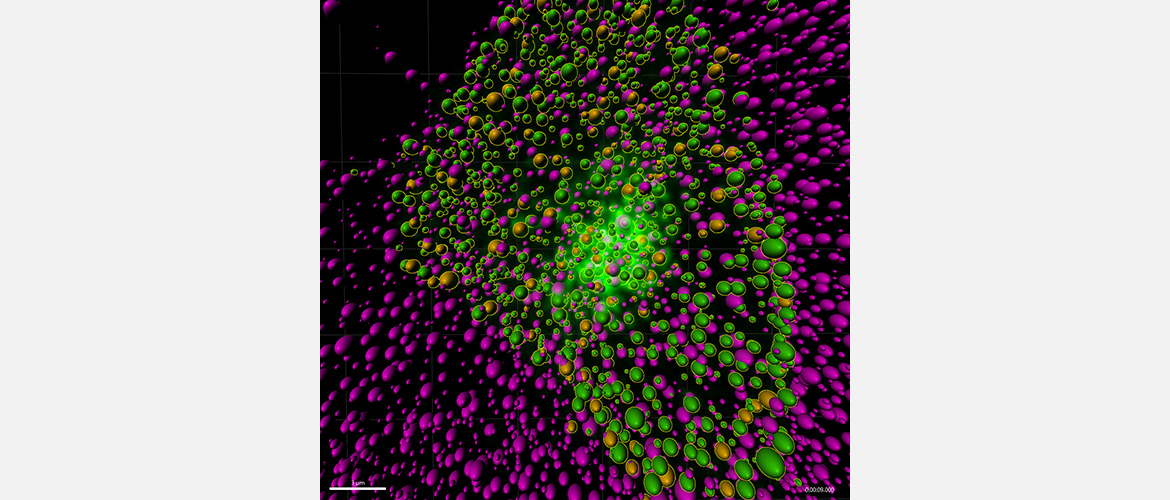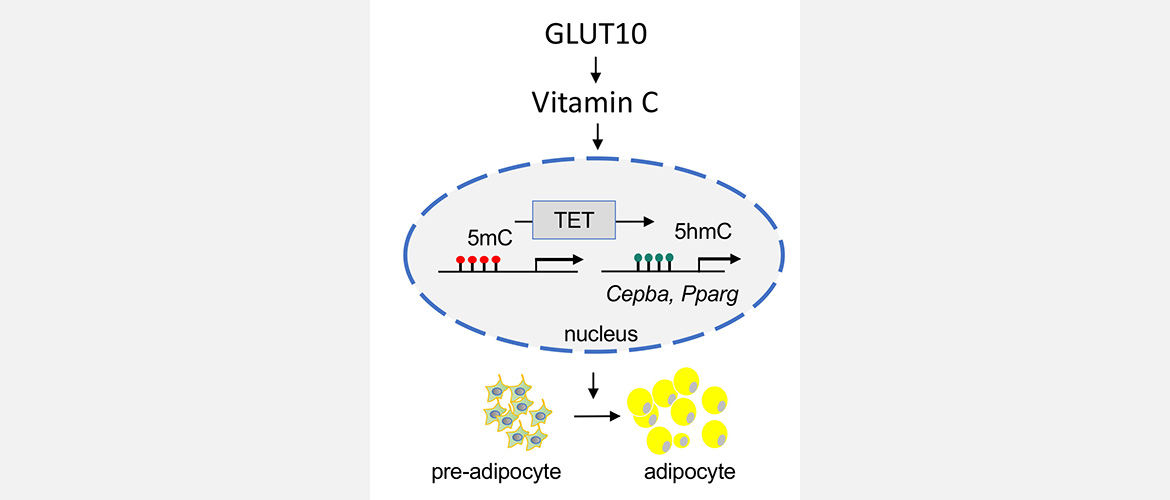李宜靜老師實驗室
-
- 專長:Human Genetic Diseases, Developmental Biology
- 信箱:yiching@gate.sinica.edu.tw
- 電話:02-2787-1550
- 位置:R502/ICOB



實驗室目標:
複雜疾病的發展甚至罕見疾病的發展,同時受到遺傳、環境和生活方式因素共同影響。我們研究致力於了解影響遺傳疾病風險和進展的遺傳因子和環境因子間相互作用。這些研究將提供策略以預防或延緩遺傳疾病的發展,有助於個人化醫療和開發。
我們的策略:
利用族群研究來了解遺傳疾病遺傳因子和環境間相互作用,但仍然極具挑戰性。我們實驗室目前從了解罕見疾病的致病基因和致病途徑開始,近一步了解影響發病途徑的環境因子,來研究相關的複雜遺傳疾病。
目前研究主題:
我們目前研究專注於結締組織疾病,因為許多老化常見疾病與結締組織有關,而且遺傳因子和以及飲食和生活習慣對這些疾病的發展有很大影響。包含心血管,骨骼,關節,代謝,癌症相關疾病。
1.了解罕見的結締組織疾病,致病基因功能和致病途徑。動脈迂曲綜合徵(ATS)是由於葡萄糖轉運蛋白10 (GLUT10) 基因突變,引起功能缺失所造成。ATS許多病徵與老化相關的結締組織疾病相似。我們利用小鼠與細胞系統,研究GLUT10功能、影響結締組織發育及功能維持。
2.了解致病基因功能和致病途徑,如何與年齡、飲食和微環境變化交互作用,影響相關疾病進展。利用小鼠與細胞系統,了解環境變化如何影響GLUT10功能與其發病途徑,影響ATS進展。進而在ATS患者,跟發病途徑相關常見結締組織疾病族群做更近一步驗證。
3.開發治療FGFR3 過度活化相關的軟骨發育不全 (ACH)和其他骨骼發育不良罕見疾病,以及相關癌症的新治療策略。我們建立藥物篩選系統,ACH和癌症小鼠模式,更進一步暸解致病機制,並開發治療策略。
我們也積極參與合作研究,暸解跟疾病相關基因,發病機制,並開發潛在的診斷和預防策略。希望這些研究將提供策略以預防或延緩遺傳疾病的發展,有助於個人化醫療和開發。
| 姓名 | 職稱 | 電話 | 備註 | |
|---|---|---|---|---|
| Yi-Ching Lee | Associate Research Fellow | 02-27871550 | yiching@gate.sinica.edu.tw | |
| Anu Chirackal Joe | PhD student/TIGP | 02-27871549 | 無 | |
| 陳威廷 | Research Assistant | 02-27871549 | 無 | 2022- |
| 林慧敏 | Research Assistant | 02-27871549 | 無 | 2024- |
| 林韻文 | PhD student | 無 | 無 | 2024 graduate |
| Abhishek Negi | PhD rotation student/TIGP | 無 | 無 | 2022 |
| Thu Trang Nguyen | Research Assistant | 無 | 無 | 2021-2022 |
| Megan Liaw | Research Assistant | 無 | 無 | 2020-2021 |
| 曹昌玉 | Research Assistant | 無 | 無 | 2019-2021 |
| 江忠霖 | Research Assistant | 無 | 無 | 2015-2019 |
*: Corresponding author; #: Equal contribution
1. Lin YW, Kao HJ, Chen WT, Kao CF, Wu JY, Chen YT, Lee YC* (2023) Cell-based screen identifies porphyrins as FGFR3 activity inhibitors with therapeutic potential for achondroplasia and cancer. JCI Insight 8 (22). doi:10.1172/jci.insight.171257
2. Jiang CL, Tsao CY, Lee YC* (2022) Vitamin C attenuates predisposition to high-fat diet-induced metabolic dysregulation in GLUT10-deficient mouse model. Genes Nutr 17 (1):10. doi:10.1186/s12263-022-00713-y
3. Wagner BM, Robinson JW, Lin YW, Lee YC, Kaci N, Legeai-Mallet L, Potter LR (2021) Prevention of guanylyl cyclase-B dephosphorylation rescues achondroplastic dwarfism. JCI Insight 6 (9). doi:10.1172/jci.insight.147832
4. Tseng TL, Wang YT, Tsao CY, Ke YT, Lee YC, Hsu HJ, Poss KD, Chen CH (2021) The RNA helicase Ddx52 functions as a growth switch in juvenile zebrafish. Development 148 (15). doi:10.1242/dev.199578
5. Johnson TA, Mashimo Y, Wu JY, Yoon D, Hata A, Kubo M, Takahashi A, Tsunoda T, Ozaki K, Tanaka T, Ito K, Suzuki H, Hamada H, Kobayashi T, Hara T, Chen CH, Lee YC, et al., Korean Kawasaki Disease Genetics Consortium TKDGCTPIDAJKDGC, Lee JK, Chen YT, Onouchi Y (2021) Association of an IGHV3-66 gene variant with Kawasaki disease. J Hum Genet 66 (5):475-489. doi:10.1038/s10038-020-00864-z
6. Jiang CL, Jen WP, Tsao CY, Chang LC, Chen CH, Lee YC* (2020) Glucose transporter 10 modulates adipogenesis via an ascorbic acid-mediated pathway to protect mice against diet-induced metabolic dysregulation. PLoS Genet 16 (5):e1008823. doi:10.1371/journal.pgen.1008823
7. Jen WP, Chen HM, Lin YS, Chern Y, Lee YC *(2020) Twist1 Plays an Anti-apoptotic Role in Mutant Huntingtin Expression Striatal Progenitor Cells. Mol Neurobiol 57 (3):1688-1703. doi:10.1007/s12035-019-01836-x
8. Ko TM, Chang JS, Chen SP, Liu YM, Chang CJ, Tsai FJ, Lee YC, Chen CH, Chen YT, Wu JY (2019) Genome-wide transcriptome analysis to further understand neutrophil activation and lncRNA transcript profiles in Kawasaki disease. Sci Rep 9 (1):328. doi:10.1038/s41598-018-36520-y
9. Syu YW, Lai HW, Jiang CL, Tsai HY, Lin CC, Lee YC* (2018) GLUT10 maintains the integrity of major arteries through regulation of redox homeostasis and mitochondrial function. Hum Mol Genet 27 (2):307-321. doi:10.1093/hmg/ddx401
10. Lenka G, Tsai MH, Lin HC, Hsiao JH, Lee YC, Lu TP, Lee JM, Hsu CP, Lai LC, Chuang EY (2017) Identification of Methylation-Driven, Differentially Expressed STXBP6 as a Novel Biomarker in Lung Adenocarcinoma. Sci Rep 7:42573. doi:10.1038/srep42573
11. Lee YC*, Song IW, Pai YJ, Chen SD, Chen YT (2017) Knock-in human FGFR3 achondroplasia mutation as a mouse model for human skeletal dysplasia. Sci Rep 7:43220. doi:10.1038/srep43220
12. Ko TM, Kuo HC, Chang JS, Chen SP, Liu YM, Chen HW, Tsai FJ, Lee YC, Chen CH, Wu JY, Chen YT (2015) CXCL10/IP-10 is a biomarker and mediator for Kawasaki disease. Circ Res 116 (5):876-883. doi:10.1161/CIRCRESAHA.116.305834
13. Lin YC, Lee YC, Li LH, Cheng CJ, Yang RB (2014) Tumor suppressor SCUBE2 inhibits breast-cancer cell migration and invasion through the reversal of epithelial-mesenchymal transition. J Cell Sci 127 (Pt 1):85-100. doi:10.1242/jcs.132779
14. Chen CH, Lee CS, Lee MT, Ouyang WC, Chen CC, Chong MY, Wu JY, Tan HK, Lee YC, et., al., Chen YT, Cheng AT, Taiwan Bipolar C (2014) Variant GADL1 and response to lithium therapy in bipolar I disorder. N Engl J Med 370 (2):119-128. doi:10.1056/NEJMoa1212444
15. Chang CJ, Kuo HC, Chang JS, Lee JK, Tsai FJ, Khor CC, Chang LC, Chen SP, Ko TM, Liu YM, Chen YJ, Hong YM, Jang GY, Hibberd ML, Kuijpers T, Burgner D, Levin M, Burns JC, Davila S, International Kawasaki Disease Genetics C, Korean Kawasaki Disease Genetics C, Taiwan Kawasaki Disease Genetics C, Chen YT, Chen CH, Wu JY, Lee YC*(2013) Replication and meta-analysis of GWAS identified susceptibility loci in Kawasaki disease confirm the importance of B lymphoid tyrosine kinase (BLK) in disease susceptibility. PLoS One 8 (8):e72037. doi:10.1371/journal.pone.0072037
16. Lee YC, Kuo HC, Chang JS, Chang LY, Huang LM, Chen MR, Liang CD, Chi H, Huang FY, Lee ML, Huang YC, Hwang B, Chiu NC, Hwang KP, Lee PC, Chang LC, Liu YM, Chen YJ, Chen CH, Taiwan Pediatric IDA, Chen YT, Tsai FJ, Wu JY (2012) Two new susceptibility loci for Kawasaki disease identified through genome-wide association analysis. Nat Genet 44 (5):522-525. doi:10.1038/ng.2227
17. Tsai FJ#, Lee YC#, Chang JS, Huang LM, Huang FY, Chiu NC, Chen MR, Chi H, Lee YJ, Chang LC, Liu YM, Wang HH, Chen CH, Chen YT, Wu JY (2011) Identification of novel susceptibility Loci for kawasaki disease in a Han chinese population by a genome-wide association study. PLoS One 6 (2):e16853. doi:10.1371/journal.pone.0016853
18. Lee YC, Chang CJ, Bali D, Chen YT, Yan YT (2011) Glycogen-branching enzyme deficiency leads to abnormal cardiac development: novel insights into glycogen storage disease IV. Hum Mol Genet 20 (3):455-465. doi:10.1093/hmg/ddq492
19. Khor CC#, Davila S#, Breunis WB#, Lee YC#, Set al., Hong Kong-Shanghai Kawasaki Disease Genetics C, Korean Kawasaki Disease Genetics C, Taiwan Kawasaki Disease Genetics C, International Kawasaki Disease Genetics C, Consortium USKDG, Blue Mountains Eye S (2011) Genome-wide association study identifies FCGR2A as a susceptibility locus for Kawasaki disease. Nat Genet 43 (12):1241-1246. doi:10.1038/ng.981
20. Cheng PY, Lin YP, Chen YL, Lee YC, Tai CC, Wang YT, Chen YJ, Kao CF, Yu J (2011) Interplay between SIN3A and STAT3 mediates chromatin conformational changes and GFAP expression during cellular differentiation. PLoS One 6 (7):e22018. doi:10.1371/journal.pone.0022018
21. Saha A, Lee YC, Zhang Z, Chandra G, Su SB, Mukherjee AB (2010) Lack of an endogenous anti-inflammatory protein in mice enhances colonization of B16F10 melanoma cells in the lungs. J Biol Chem 285 (14):10822-10831. doi:10.1074/jbc.M109.083550
22. Lee YC, Huang HY, Chang CJ, Cheng CH, Chen YT (2010) Mitochondrial GLUT10 facilitates dehydroascorbic acid import and protects cells against oxidative stress: mechanistic insight into arterial tortuosity syndrome. Hum Mol Genet 19 (19):3721-3733. doi:10.1093/hmg/ddq286
23. Cheng CH, Kikuchi T, Chen YH, Sabbagha NG, Lee YC, Pan HJ, Chang C, Chen YT (2009) Mutations in the SLC2A10 gene cause arterial abnormalities in mice. Cardiovasc Res 81 (2):381-388. doi:10.1093/cvr/cvn319
24. Saha A, Kim SJ, Zhang Z, Lee YC, Sarkar C, Tsai PC, Mukherjee AB (2008) RAGE signaling contributes to neuroinflammation in infantile neuronal ceroid lipofuscinosis. FEBS Lett 582 (27):3823-3831. doi:10.1016/j.febslet.2008.10.015
25. Kim SJ, Zhang Z, Sarkar C, Tsai PC, Lee YC, Dye L, Mukherjee AB (2008) Palmitoyl protein thioesterase-1 deficiency impairs synaptic vesicle recycling at nerve terminals, contributing to neuropathology in humans and mice. J Clin Invest 118 (9):3075-3086. doi:10.1172/JCI33482
26. Zhang Z#, Lee YC#, Kim SJ, Choi MS, Tsai PC, Saha A, Wei H, Xu Y, Xiao YJ, Zhang P, Heffer A, Mukherjee AB (2007) Production of lysophosphatidylcholine by cPLA2 in the brain of mice lacking PPT1 is a signal for phagocyte infiltration. Hum Mol Genet 16 (7):837-847. doi:10.1093/hmg/ddm029
27. Zhang Z#, Lee YC#, Kim SJ, Choi MS, Tsai PC, Xu Y, Xiao YJ, Zhang P, Heffer A, Mukherjee AB (2006) Palmitoyl-protein thioesterase-1 deficiency mediates the activation of the unfolded protein response and neuronal apoptosis in INCL. Hum Mol Genet 15 (2):337-346. doi:10.1093/hmg/ddi451
28. Zhang Z, Kim SJ, Chowdhury B, Wang J, Lee YC, Tsai PC, Choi M, Mukherjee AB (2006) Interaction of uteroglobin with lipocalin-1 receptor suppresses cancer cell motility and invasion. Gene 369:66-71. doi:10.1016/j.gene.2005.10.027
29. Ray R, Zhang Z, Lee YC, Gao JL, Mukherjee AB (2006) Uteroglobin suppresses allergen-induced TH2 differentiation by down-regulating the expression of serum amyloid A and SOCS-3 genes. FEBS Lett 580 (25):6022-6026. doi:10.1016/j.febslet.2006.09.059
30. Lee YC, Zhang Z, Mukherjee AB (2006) Mice lacking uteroglobin are highly susceptible to developing pulmonary fibrosis. FEBS Lett 580 (18):4515-4520. doi:10.1016/j.febslet.2006.07.031
31. Kim SJ, Zhang Z, Lee YC, Mukherjee AB (2006) Palmitoyl-protein thioesterase-1 deficiency leads to the activation of caspase-9 and contributes to rapid neurodegeneration in INCL. Hum Mol Genet 15 (10):1580-1586. doi:10.1093/hmg/ddl078
32. Kim SJ, Zhang Z, Hitomi E, Lee YC, Mukherjee AB (2006) Endoplasmic reticulum stress-induced caspase-4 activation mediates apoptosis and neurodegeneration in INCL. Hum Mol Genet 15 (11):1826-1834. doi:10.1093/hmg/ddl105
33. Lee YC, Lu, C.A., Casaretto, J.a., and Yu, S.M., (2003) An ABA-responsive bZIP protein, OsBZ8, mediates sugar repression of α-amylase gene expression. Physiologia Plantarum 119 (1):78-86
34. Yu SM#, Lee YC#, Fang SC, Chan MT, Hwa SF, Liu LF (1996) Sugars act as signal molecules and osmotica to regulate the expression of alpha-amylase genes and metabolic activities in germinating cereal grains. Plant Mol Biol 30 (6):1277-1289. doi:10.1007/bf00019558